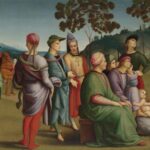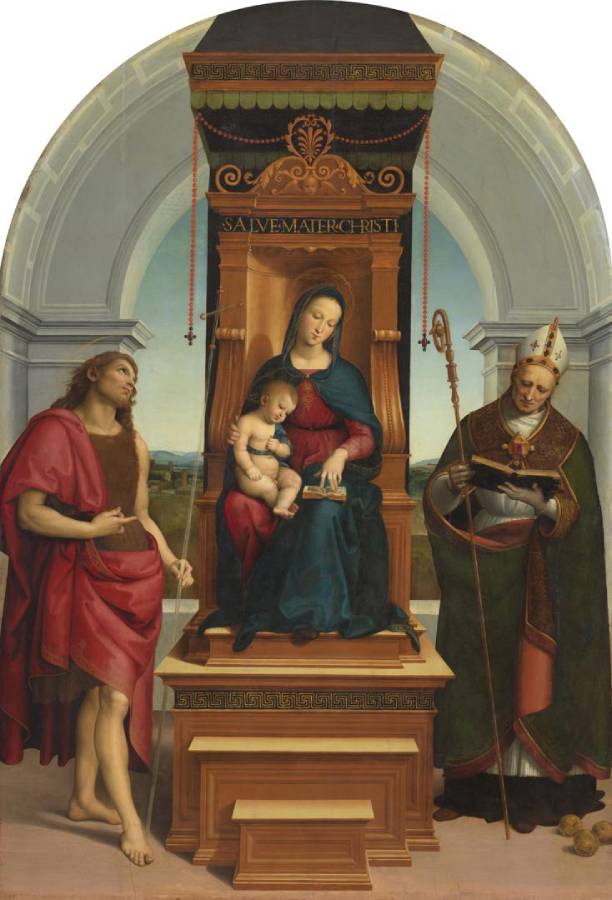Raffaello (1483-1520)
Madonna Ansidei (Ansidei Madonna: The Virgin and Child with Saint John the Baptist and Saint Nicholas of Bari)
1505
Oil on poplar, 216.8 × 147.6 cm
National Gallery, London
This is the main panel of the Ansidei Altarpiece that the 22-year-old Raphael painted for the Ansidei family chapel in the Servite Church of S. Fiorenzo in Perugia in 1505.
The Virgin sits in majesty on a carved wooden throne with the Christ Child upright and alert on her lap. A small book is open on her knee and she follows the text she is reading with her finger. She draws her baby’s attention to a passage in the book, presumably containing allusions to his future sacrifice. A string of coral beads ending in jewelled crosses is suspended from the throne and resembles a rosary, a reminder of the blood Christ will shed at the Crucifixion. The Latin inscription at the top of the throne, ‘SALVE MATER CHRISTI’ (‘Hail Mother of Christ’), would have acted as a prompt to the recitation of the rosary.
John the Baptist points to the infant Christ and gazes at his rock crystal cross, in foreknowledge of Christ’s future death. The older, more contemplative Saint Nicholas, identified by his bishop’s mitre and crosier, withdraws slightly behind the throne. His furrowed brow indicates that he is concentrating on his book. At his feet are three golden balls which represent the purses of gold he gave as dowries to the three daughters of an impoverished nobleman to save them from prostitution. This type of composition, with saints flanking the enthroned Virgin and Child in a unified image, is known as a sacra conversazione (’sacred conversation’).
The lower horizontal panel, known as the predella, beneath the main panel of the altarpiece probably depicted two scenes: John the Baptist Preaching and another scene showing a posthumous miracle of Saint Nicholas. Each narrative scene would have been positioned beneath the saint in the main panel to whom it related.
Raphael carefully calculated the geometry of the composition, dividing it horizontally and vertically into harmonious thirds. The picture surface was incised with a grid nine squares wide by six squares high. This suggests that Raphael worked out his scheme in squared composition drawings on paper and then transferred the design to the panel before he began painting.
Technical investigation has revealed that the pale grey architecture and vaulting behind the Virgin’s throne, which provides a sacred space for the figures, was not planned by Raphael from the beginning but was painted over the sky and landscape. Raphael used the pre-existing grid to position the parapet a third of the way up and the mouldings two-thirds of the way up the panel. This explains why this late addition appears so integral to the composition. He may have decided to include the barrel-vaulted architecture in the altarpiece to compensate for the plainness of the Ansidei Chapel.
The Ansidei Madonna is the grandest and most successfully designed of Raphael’s early Madonnas. The painting is closest in style and form to the Colonna Altarpiece (Metropolitan Museum of Art, New York), which gives an idea of how the Ansidei Madonna would have appeared before Raphael added the architectural backdrop. (NG)
Predella:
 Raffaello (1483-1520)
Raffaello (1483-1520)
La predicazione di San Giovanni Battista
1505
National Gallery, London
Raphael painted this altarpiece for the Ansidei family chapel dedicated to Saint Nicholas in the Servite Church of S. Fiorenzo in Perugia. The chapel had been built in 1484 by Filippo di Ansideo di Simone ‘de Catrano’, a wealthy wool merchant. His will of December 1490 left funds for maintaining the chapel as well as for his burial in the church.
The altarpiece would have been made up of the main panel, featuring the enthroned Virgin Mary and Christ Child flanked by Saint Nicholas on the right and Saint John the Baptist on the left, and a lower horizontal painted panel known as a predella. One of the two scenes from the predella, Saint John the Baptist preaching, is also in the National Gallery’s collection. The other predella scene, which probably depicted a posthumous miracle of Saint Nicholas, is missing.
Niccolò (1469–after 1527), Filippo’s eldest son, inherited his father’s business interests and probably also became patron of the chapel. It was most likely he who commissioned the 22-year-old Raphael to paint the altarpiece in around 1504–5. The two saints in the altarpiece – Nicholas and John the Baptist – reflect his own name and that of his son Giovanni Battista. The date MDV (1505) is inscribed in gold on the hem of the Virgin’s mantle. As he was from Perugia, Niccolò probably wanted to commission an altarpiece in the style of the famous local artist Perugino. His decision to employ Raphael may have been because the artist was influenced by Perugino and had probably also worked with him after his move to the city in 1502.
This type of unified single panel altarpiece, in which the enthroned Virgin and Child are accompanied by saints, is known as a sacra conversazione (‘holy conversation’). It developed from the earlier style of altarpiece known as a polyptych, in which the Virgin and Child would be represented in a central panel and the saints depicted separately in individual flanking panels. Although the saints here are not literally conversing, there is a sense of quiet communion between them.
The Ansidei altar was originally located on a pier at the crossing of the church. The altar was demolished when the church underwent extensive renovations in 1768–70. Shortly before this, Raphael’s altarpiece with part of the predella was sold by the monks of S. Fiorenzo to pay for the building works. The Ansidei Madonna and predella panel of Saint John the Baptist Preaching were purchased by the National Gallery in 1885. (NG)
